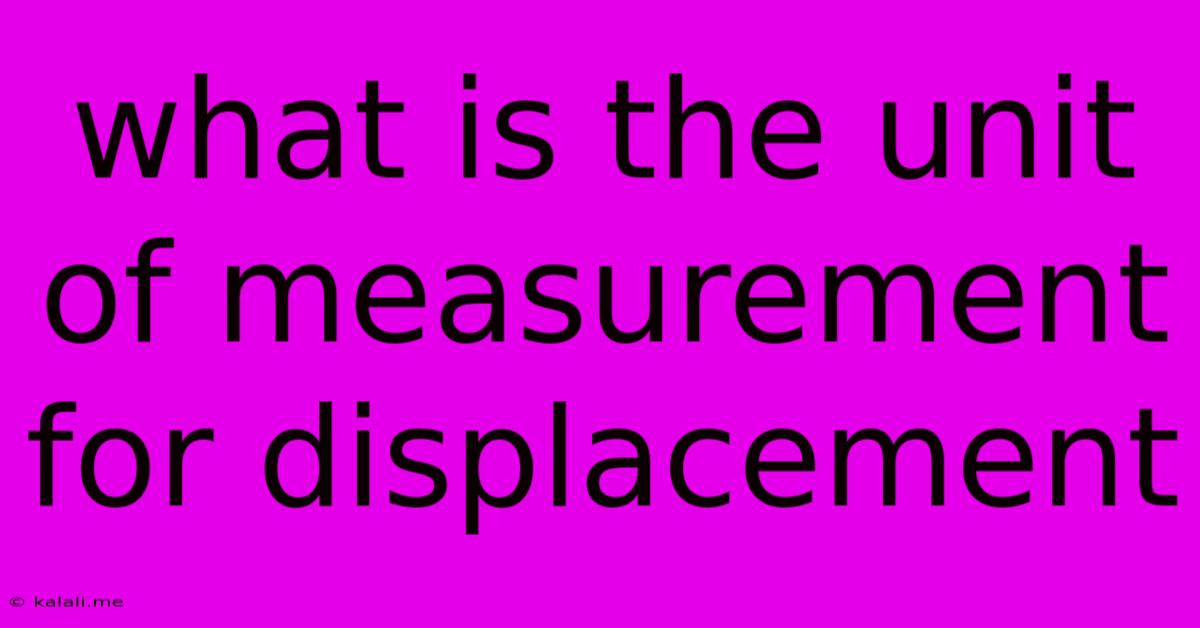What Is The Unit Of Measurement For Displacement
Kalali
Jun 13, 2025 · 3 min read

Table of Contents
What is the Unit of Measurement for Displacement?
Understanding displacement is crucial in various fields, from mechanics to fluid dynamics. But before delving into its applications, let's address the fundamental question: what unit measures displacement? This article will explore the units used to measure displacement, clarify any potential confusion with related concepts like distance and distance traveled, and provide examples of displacement in different contexts.
Displacement is a vector quantity that describes the change in position of an object. It's the shortest distance between the object's initial and final positions, and importantly, it includes the direction of that change. This is a key difference from distance, which is a scalar quantity and only considers the magnitude of the path traveled. Think of it like this: you might walk 1 kilometer (distance) around a park, but your displacement could be zero if you end up back where you started.
The standard unit of measurement for displacement in the International System of Units (SI) is the meter (m). Since displacement is a vector, the meter is often accompanied by a direction. For example, "5 meters east" or "10 meters at 30 degrees North of East".
Other Units of Displacement
While the meter is the primary SI unit, other units are used depending on the scale of the displacement:
- Kilometer (km): Used for larger displacements, such as distances between cities.
- Centimeter (cm): Used for smaller displacements, like the movement of a component in a machine.
- Millimeter (mm): Frequently used in engineering and precision measurements.
- Micrometer (µm): Used for extremely small displacements, like those at a microscopic level.
- Angstrom (Å): A smaller unit used in atomic and molecular physics.
The choice of unit depends entirely on the context. Measuring the displacement of a continent will require kilometers, while measuring the displacement of a piston in an engine will use millimeters or even micrometers.
Displacement vs. Distance: A Crucial Distinction
It's vital to differentiate between displacement and distance. Distance is the total length of the path traveled, regardless of direction. Displacement, on the other hand, is the straight-line distance between the starting and ending points, considering direction.
For instance, consider a car driving around a circular track with a circumference of 1 kilometer. After one lap, the distance traveled is 1 kilometer. However, the displacement is zero because the car is back where it started. This highlights the vector nature of displacement.
Applications of Displacement Measurement
Understanding and measuring displacement is essential in numerous fields:
- Physics: Calculating velocity and acceleration.
- Engineering: Designing and analyzing mechanical systems (e.g., engines, robotics).
- Navigation: Determining the position of ships, aircraft, and satellites.
- Geology: Studying tectonic plate movements.
- Medicine: Tracking the movement of internal organs.
Accurate measurement of displacement often requires specialized tools and techniques, depending on the scale and application. These range from simple rulers and measuring tapes to sophisticated laser interferometers and GPS systems.
In conclusion, while the meter (m) is the fundamental SI unit for displacement, the appropriate unit will vary depending on the magnitude of the displacement being measured. Remembering the crucial difference between displacement (a vector) and distance (a scalar) is essential for accurate calculations and a thorough understanding of motion.
Latest Posts
Latest Posts
-
What Is The Prime Factorization Of 225
Jun 14, 2025
-
Write 80 As A Product Of Prime Factors
Jun 14, 2025
-
Magnetic Field Lines Inside A Bar Magnet
Jun 14, 2025
-
Which Of The Following Is True Of Classical Conditioning
Jun 14, 2025
-
Which Of The Following Is In The Correct Order
Jun 14, 2025
Related Post
Thank you for visiting our website which covers about What Is The Unit Of Measurement For Displacement . We hope the information provided has been useful to you. Feel free to contact us if you have any questions or need further assistance. See you next time and don't miss to bookmark.